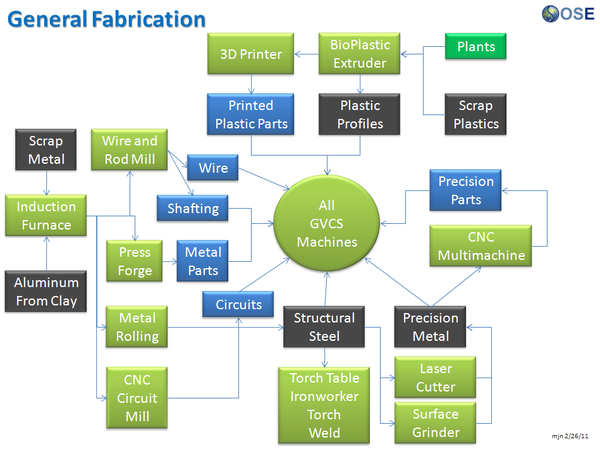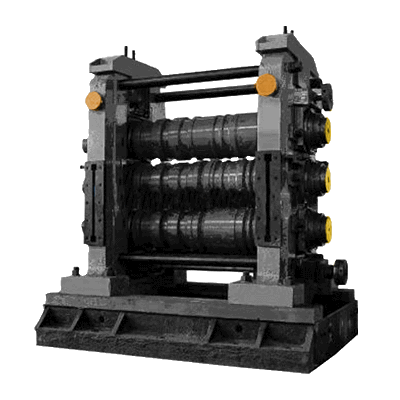Metal Roller: Difference between revisions
No edit summary |
(added LANG template) |
||
| (24 intermediate revisions by 3 users not shown) | |||
| Line 1: | Line 1: | ||
{{ | {{OrigLang}} | ||
{{GVCS Header}} | |||
==Overview== | |||
[[Image:Metal Roller.png|thumb|400px|Metal Roller]] | |||
The metal roller sends sheet metal and plate through gaps between cylinders to roll-bend them; this operation is used for producing cylindrical or conical components as well as wiring cylindrical edges. | |||
This roll-bending operation ability is particularly useful for producing standard shapes of metal that would be time-consuming or impossible to form otherwise. | |||
{{Video}} | |||
=Description= | |||
Metal rolling is a centralized industrial process that is done in large-scale (kiloton per day) steel mills. We aim to open-source this technology for use in small-scale (ton per day) flexible fabrication facilities which allow local communities to produce virgin metal from scrap feedstocks. | |||
=Description= | |||
One type of metal roller uses a pinch rolling operations (lightly grips and moves sheet metal through the machine with a "free" roller to "set" the required bend radius) and pyramid rolling operations (moves plate metal through the machine to "set" the required bend radius). A hydraulically power-driven universal metal roller can be used for all required roll-bending operations. | |||
==Solution Statement== | |||
The metal roller allows the operator to perform roll-bending operations with ease. | |||
==Product Ecology== | |||
'''Made with''' | |||
*{{Induction Furnace}} | |||
*{{Torch Table}} | |||
*{{Welder}} | |||
'''Uses''' | |||
*{{Power Cube}} - Power | |||
*{{Induction Furnace}} - Steel | |||
'''Creates''' | |||
*Rolled Steel | |||
[[Image:2b-Genfabecology.png|thumb|600px|General Fabrication [[Product Ecology]]]] | |||
See [[Product Ecology]] for more information. | |||
==Components== | |||
The principal elements of the metal roller include: | |||
*'''Frame''': the ground-supported structure upon which the rest of the metal roller lies | |||
*'''Couplers''': the mechanisms that convert rotary motion from the hydraulic motor to the cylinders | |||
*'''Hydraulic Circuit''': the set of components that powers the hydraulic motor by sending pressurized fluid through its ports, hence producing rotary motion at the motor shaft | |||
*'''Adjusters''': the mechanisms that allow cylinder movement for different placement configurations on the plane perpendicular to the axis of rotation | |||
*'''Cylinders''': the components that make actual contact with the workpiece for roll-bending. | |||
==Status== | |||
The Metal Roller is [[Metal_Roller/Research_Development#Next_steps|currently in the research phase of development]]. Prototyping is planned for after product release of the [[Induction Furnace]]. | |||
=See Also= | |||
*[[Metal Roller/Research Development | Research]] | |||
*[http://en.wikipedia.org/wiki/Rolling_(metalworking) Wikipedia: Metal Rolling] | |||
*[http://www.youtube.com/results?search_query=metal+rolling&aq=f YouTube: Metal Rolling] | |||
{{GVCS Footer}} | |||
Latest revision as of 10:37, 9 March 2017
| Metal Roller | ||
|---|---|---|
| Home | Research & Development | Bill of Materials | Manufacturing Instructions | User's Manual | User Reviews | 
| |
Overview
The metal roller sends sheet metal and plate through gaps between cylinders to roll-bend them; this operation is used for producing cylindrical or conical components as well as wiring cylindrical edges.
This roll-bending operation ability is particularly useful for producing standard shapes of metal that would be time-consuming or impossible to form otherwise.
Description
Metal rolling is a centralized industrial process that is done in large-scale (kiloton per day) steel mills. We aim to open-source this technology for use in small-scale (ton per day) flexible fabrication facilities which allow local communities to produce virgin metal from scrap feedstocks.
Description
One type of metal roller uses a pinch rolling operations (lightly grips and moves sheet metal through the machine with a "free" roller to "set" the required bend radius) and pyramid rolling operations (moves plate metal through the machine to "set" the required bend radius). A hydraulically power-driven universal metal roller can be used for all required roll-bending operations.
Solution Statement
The metal roller allows the operator to perform roll-bending operations with ease.
Product Ecology
Made with
Uses
 Power Cube - Power
Power Cube - Power Induction Furnace - Steel
Induction Furnace - Steel
Creates
- Rolled Steel

See Product Ecology for more information.
Components
The principal elements of the metal roller include:
- Frame: the ground-supported structure upon which the rest of the metal roller lies
- Couplers: the mechanisms that convert rotary motion from the hydraulic motor to the cylinders
- Hydraulic Circuit: the set of components that powers the hydraulic motor by sending pressurized fluid through its ports, hence producing rotary motion at the motor shaft
- Adjusters: the mechanisms that allow cylinder movement for different placement configurations on the plane perpendicular to the axis of rotation
- Cylinders: the components that make actual contact with the workpiece for roll-bending.
Status
The Metal Roller is currently in the research phase of development. Prototyping is planned for after product release of the Induction Furnace.
See Also


